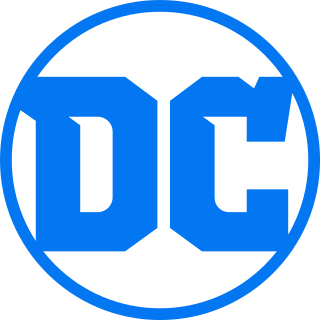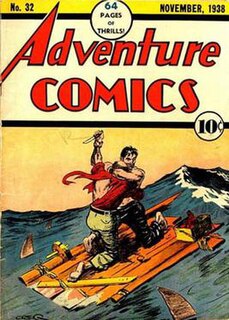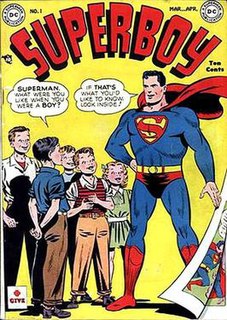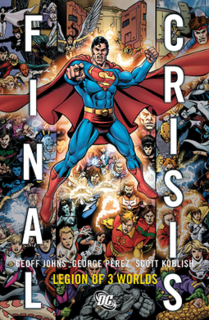Plot
At the Legion of Super-Heroes' headquarters in the 30th century, Superboy, Duo Damsel, Mon-El and Shadow Lass race toward the Time Chamber, in an effort to escape the sorcerer Mordru, the Dark Lord. A being of near-limitless mystical power, Mordru conquered much of the galaxy until he was imprisoned in an airless steel block by Superboy and Mon-El. He remained locked away at Legion HQ until he was accidentally freed by Shadow Lass, a relatively new member of the team. [1] With his mastery of magic (the one weakness shared by both Superboy and Mon-El) and with all the other Legionnaires seemingly destroyed, the team is forced to retreat. They travel to the 20th century and seek refuge in Superboy's hometown, Smallville.

The Legion of Super-Heroes is a fictional superhero team appearing in American comic books published by DC Comics. Created by writer Otto Binder and artist Al Plastino, the Legion is a group of superpowered beings living in the 30th and 31st centuries of the DC Comics Universe, and first appears in Adventure Comics #247.

Superboy is a fictional superhero that appears in American comic books published by DC Comics. The character was created by Jerry Siegel and Don Cameron and is based on the character of Superman that Siegel co-created with Joe Shuster. Superboy first appeared in the comic book More Fun Comics #101 in 1945.

Triplicate Girl is a fictional character, a superhero in the 30th and 31st centuries of the DC Comics Universe and a member of the Legion of Super-Heroes. She has also had the aliases Duo Damsel, Triad, Una, Duplicate Damsel and Duplicate Girl.
Duo Damsel and Shadow Lass adopt secret identities which allow them to hide at the homes of Police Chief Douglas Parker and Lana Lang, while Mon-El stays with the Kents in his old guise as Clark's cousin Bob Cobb. [2] Soon thereafter Mordru blankets Smallville in a mystical shadow in an effort to locate the Legionnaires. When the shadow touches the town's residents, their minds are possessed by Mordru (although Shadow Lass' powers protects the Legionnaires from being detected). Meanwhile, Duo Damsel cries herself to sleep when Superboy fails to notice her romantic feelings for him.
Chief Douglas Parker is a supporting character in stories published by DC Comics featuring Superboy, the younger version of Superman.

Lana Lang is a fictional supporting character appearing in American comic books published by DC Comics. She has appeared in other media adaptations of Superman, typically as a teenager. These portrayals include the Adventures of Superboy television series in which Stacy Haiduk played her, and the WB television series Smallville played by Kristin Kreuk. In Superman: The Movie Lana was played by Diane Sherry. In the 1983 film Superman III, she is played by Annette O'Toole, who would later portray Martha Kent on Smallville.

Jonathan Kent and Martha Kent, often referred to as "Pa" and "Ma" Kent (respectively), are the fictional adoptive parents of Superman. They live in the rural town of Smallville, Kansas. In most versions of Superman's origin story, Jonathan and Martha were the first to come across the rocket that brought the infant Kal-El, with their adopting him shortly thereafter, renaming him Clark Kent, "Clark" being Martha's maiden name.
Mordru attempts to flush the Legionnaires out of hiding by creating a myriad of disasters throughout the town, but the teens recognize that the calamities are illusions and ignore them. After a week passes without Superboy being seen, a group of gangsters tries to seize control of Smallville — but the Legionnaires defeat them in their civilian identities. Later, Lana spies the Legionnaires in costume, which allows Mordru to find them. The teens barely manage to escape a second time. Since the wizard is capable of probing their minds, the Legionnaires resume their civilian guises and use a hypnotic device to erase their own memories of their true identities.
After several weeks have passed, Mordru encases Smallville in an impenetrable shield and lifts the town into orbit above Earth. He then unleashes his 30th century soldiers upon the people of Smallville. The Legionnaires, robbed of their memories, provide no protection. Clark Kent's best friend Pete Ross, who is fully aware that Clark is Superboy, [3] realizes that the Boy of Steel has forgotten his super-identity. Since both Pete and Lana have auxiliary Legionnaire status, [4] he enlists her aid, but is forced to reveal that Clark is Superboy. The two manage to jog Clark's memory by showing him that, like Superboy, his hair is unbreakable. He then retrieves the hypnotic device and restores the memories of his teammates.

Peter Joseph Ross is a fictional character appearing in American comic books published by DC Comics.
The Legionnaires — including Pete and Lana (in her guise as Insect Queen) — launch an attack on Mordru, but they are all captured. The wizard conjures several of the 30th century's most notorious criminals and places the Legionnaires on trial in a mock courtroom. Acting as defense attorney, Pete tries to convince the jurors that Mordru will be a threat to them if he is not stopped. Later, one of the jurors — the sorcerer Wraithor — tries to help the Legionnaires escape through an underground cavern, but is discovered by Mordru and killed. Mordru then summons a massive fireball of force in an effort to destroy the Legionnaires once and for all, but the energies cause the cavern to collapse. Mordru is entombed, unable to free himself.
Insect Queen is the name of several fictional characters appearing in American comic books published by DC Comics.
With all of the Legionnaires having survived, Superboy uses the hypnosis ray to erase Lana's knowledge of his secret identity. But before he can do the same to Pete, Mon-El turns the ray on Superboy, causing the Boy of Steel to forget that Pete is aware of his identity. Mon-El notes to himself that Pete must maintain his knowledge of Superboy's identity, as he is destined to save the hero's life years in the future precisely because of that knowledge. Upon returning to the 30th century, the Legionnaires discover that their teammates were not killed by Mordru after all. Dream Girl had been forewarned of Mordru's attack through one of her precognitive visions. She contacted her sister, the White Witch, [5] who cast a counter-spell which deflected Mordru's attack upon the Legion and their headquarters. Finally, Princess Projectra created an illusion which fooled the sorcerer into believing that he had succeeded.

Dream Girl is a fictional comic book superhero appearing in books published by DC Comics. A member of the Legion of Super-Heroes in the 30th and 31st centuries, the character was created by writer Edmond Hamilton and artist John Forte, and first appeared in Adventure Comics #317.

The White Witch is a fictional comic book character who exists in the DC Universe, a member of the Legion of Super-Heroes in the 30th and 31st centuries. Her real name is Mysa Nal, although her name was given as Xola Aq in Silver Age Legion stories in Adventure Comics; the revelation that her name was actually Mysa Nal was a later retcon. She is the sister of fellow Legionnaire Dream Girl and daughter of former High Seer of Naltor Kiwa Nal. Like Dream Girl, she is a native of the planet Naltor, where nearly everyone has the power of precognition; however, unlike most Naltorians, Mysa cannot foresee the future.

This page discusses the humanoid version of the character. For the post-Zero Hour/pre-Threeboot version, see Sensor.















